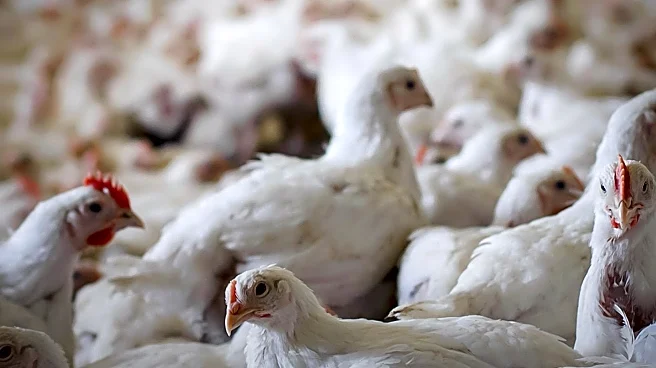What's Happening?
A recent study has validated the analytical methods for detecting clopidol residues in broiler chickens, focusing on various tissue matrices such as liver, kidney, muscle, and fat. The research aimed to ensure the reliability of analytical results by adhering to international validation standards, including specificity, limit of detection, and precision. The study found that clopidol residues were predominantly detected in the liver and kidneys shortly after administration, with concentrations decreasing significantly over time. The research also explored the metabolism of clopidol, identifying a hydroxylated metabolite in the kidney and liver. The study assessed the estimated daily intake (EDI) of clopidol for different age groups, finding that toddlers had the highest intake due to lower body weight. Hazard Quotients (HQs) were calculated to evaluate health risks, indicating that clopidol consumption through chicken meat poses no significant threat to human health.
Why It's Important?
The study's findings are crucial for the poultry industry and public health, as they provide a framework for assessing the safety of clopidol residues in chicken products. By validating detection methods and assessing health risks, the research supports regulatory standards that protect consumers from potential adverse effects. The study highlights the importance of monitoring veterinary drug residues to ensure food safety and maintain consumer confidence. The results also underscore the need for ongoing research to better understand the persistence and metabolism of clopidol and other veterinary drugs in food animals, which can inform policy decisions and industry practices.
What's Next?
Further research is needed to characterize non-extractable residues (NERs) and their potential impact on human health and the environment. The study suggests that more robust extraction methodologies or enzymatic preparations could help identify these residues, which are challenging to characterize due to their strong adsorption in tissues. Additionally, the study calls for continued monitoring of clopidol and other veterinary drugs to ensure compliance with safety standards and protect public health. Regulatory agencies may consider revising guidelines based on new findings to enhance food safety measures.
Beyond the Headlines
The study raises ethical and environmental considerations regarding the use of veterinary drugs in food animals. The persistence of drug residues in tissues and their potential binding to biological materials pose risks that extend beyond immediate health concerns. These findings could influence discussions on sustainable agricultural practices and the development of safer alternatives to current veterinary drugs. The research also highlights the complexity of balancing animal health needs with consumer safety, prompting further exploration of innovative solutions in veterinary medicine.













